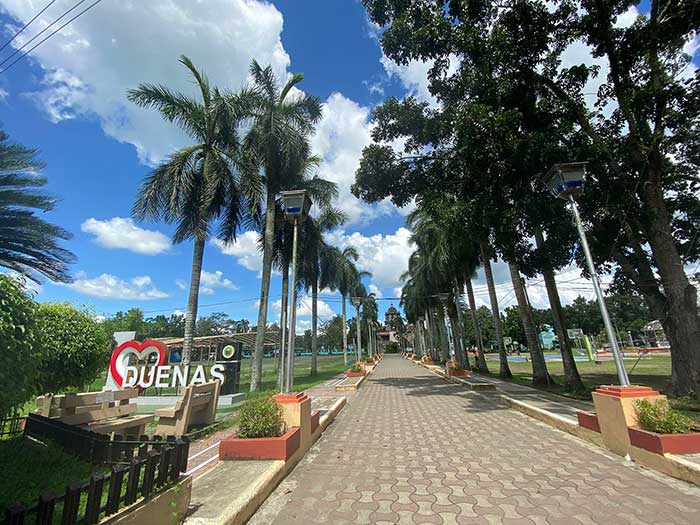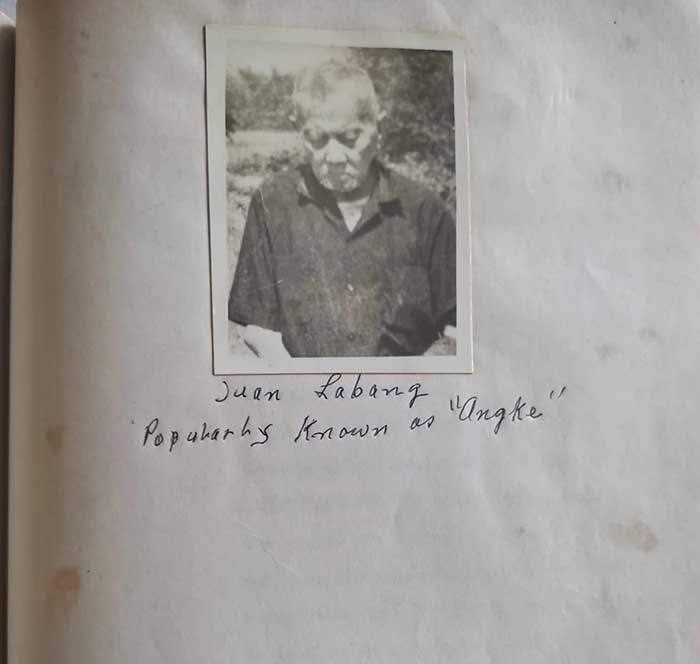By Mariela Angella Oladive
November in the Philippines marks a special season of the year.
Apart from celebrating All Saints Day and commemorating our departed loved ones during All Souls Day, it is also the time when the family gathers together, don costumes for Halloween parties, and share spooky tales, with Philippine mythical creatures like aswang are in the spotlight again.
Aligning with the recently concluded Barangay and SK elections last October 30, let us shed light on the famous teniente del barrio (equivalent to barangay captain today) in the town of Dueñas, called Teniente Gimo who was rumored to belong to a clan of aswang.
It is a common experience for Dueñasanons like me that merely mentioning the hometown often leads to a familiar set of questions: “Kilala mo si Teniente Gimo?” (Do you know Teniente Gimo?), “Ano mo si Teniente Gimo?” (Are you related to Teniente Gimo?), “Tuod gid man nga duro it aswang sa Dueñas?” (Is it true that there are a lot of aswang in Dueñas?) and sometimes, it would even be a blatant association with being an aswang.
The town and its people, for a long time, have been associated with the legendary figure of Teniente Gimo and the tales surrounding him.
But who is Teniente Gimo beyond the popular aswang lore?
Guillermo “Gimo” Labang was a successful figure in Dueñas. He was initially a native of Batad, Iloilo, but because he is ambitious and enterprising, he moved his family to a sitio near Dueñas according to the book Builders of Dueñas (1989) by local historian Ramon Lagos, Sr., which can be accessed at Museo de Iloilo.
Gimo cultivated a wide area of agriculture in Sitio Pandan, which became his huge property, for it extended up to the Ulian River.
Because he was too thrifty, he shoved society- people then called him aswang. He became Barrio Lieutenant and was later appointed Teniente Mayor (Vice Mayor). He had been Cabeza de Barangay for several years, and he died during World War II.
In another book, History of Dueñas, Facts, and Folklores (2021) by Susan Laboriante Pacheo, Dueñas tourism officer, which can also be accessed at Museo de Iloilo, described Teniente Guillermo “Gimo” Labang as a hero rather than a mythical villain.
He served as a Teniente del Barrio in Luyan (formerly Aranghilan) and was associated with resistance against both American and Spanish forces. His branding as an aswang is seen as a phenomenon called cryptozoology and part of a psych-war waged by the Spaniards.
The book also cited an account by Guillermo Gómez Rivera, a Laureled Prince of Ylongo (Ilonggo) Poetry, suggesting that Teniente Gimo’s name was Guillermo Guillerán y Dumalogdog. He was part of the Ylongo resistance under Spain against the looming US invasion, and the resistance was Batallón de Voluntarios Ylongos.
When the Americans came, the resistance was halted, but soon enough, Teniente fought against the Japanese invasion. His name was associated with the assassinations of the Japanese. Rivera claimed that Teniente Gimo’s feat is part of the Ylongo-Panayano identity. (Ibid.)
ASWANG MYTH
Looking closely at these narratives, a rumor of him being an aswang may have been propagated to silence him, echoing a phenomenon seen in Philippine history where figures like the Babaylans were branded as witches or heretics to suppress their influence.
In addition, various sources suggested that Teniente Gimo was believed to have two real names, as cited by Jordan Clark (2017) in his article Teniente Gimo, Aswang: Crippling Superstition or Brilliant Tactic?
Clark is a filmmaker and researcher who founded The Aswang Project, an educational resource about the diverse folklore of the Philippines. In his article, he referred to the documentation of Dr. Maximo Ramos’ 1971 study, The Aswang Complex in Philippine Folklore. Maximo Ramos is the Dean of Philippine Lower Mythology who authored best-selling books about Philippine folktales and Mythology.
The first is Guillermo Guillerán Gavira, believed to have lived during the transition from Spanish to American control at the turn of the 20th century. He was a volunteer during the Spanish regime and later resisted American occupation. It was rumored that he used his daughter to lure American teachers, whom he allegedly murdered and consumed. Historical evidence of these events was reported in several US publications on April 27, 1905, regarding the murders of four American school teachers near Cebu.
The second is similar to the name above, Guillermo Labang, a wealthy landowner who lived in the region during the Commonwealth era of the Philippines (1935 to 1946). Rumors circulated that a child was found dead on his land with innards strewn across the fields, and he was accused of committing the killings because he was an aswang or flesh eating ghoul.
During this period, tenant farmers faced challenges rooted in debt from the sharecropping system and a dramatic increase in population, leading to economic pressures on their families. The Commonwealth initiated an agrarian reform program, but ongoing conflicts between tenants and landowners hindered its success.
Clark argues that the stories of Teniente Gimo are more connected to the actual murders of American teachers in Cebu in 1905 than to a specific individual.
The discussed accounts, in one way or another, converge to paint a more complex picture of Teniente Gimo, moving away from the aswang myth.
However, the myth that Teniente Gimo was aswang has spread all over the country. Aswang are commonly described as flesh-eating ghouls or shape-shifting monsters. They can change from human to animal forms like a black dog, bat, bird, pig, or cat.
The stories surrounding Teniente Gimo as aswang gained prominence in the 1950s. While there are many versions of this legend, one of the most popular plots involves a dark twist.
Teniente Gimo, a Cabeza del Barrio (equivalent to a barangay captain today), was rumored to belong to a clan of aswang. The tale goes that during a town fiesta, Gimo mistakenly killed his daughter instead of her daughter’s classmate.
The narrative, as told by locals like my late grandfather, paints an eerie picture of Teniente Gimo’s daughter arriving home with a female classmate. The classmate stayed until the evening and slept in the house of Teniente Gimo beside his daughter.
In the middle of the night, the classmate woke up because of the noise outside. When she went out to find where the noise was coming from, she saw a kawa, or huge cauldron of boiling water, surrounded by Teniente Gimo and his men.
She discovered their sinister plan of killing her. Upon hearing it, she returned to the room, and in a desperate act, she cleverly switched the watch to Gimo’s daughter, who tragically became the unintended victim.
It was too late when Teniente Gimo discovered it was her daughter while the classmate had successfully fled the barrio.
After the incident, the real identity of Teniente Gimo as an aswang was revealed to the public. On one account, it was believed that he was even paraded through the whole town, announcing that he was an aswang.
Since then, Teniente Gimo’s life has been controversial and subject to many speculations and theories – not only by its townsfolk but also by outlanders who have heard his name. While other versions also circulated around, like instead of a watch, it was instead a necklace.
MODERN MYTH-SHARING
The legend of Teniente Gimo has transcended oral tradition and found its way into various media outlets, including radio dramas, films, and television shows. It was notably featured in “Shake, Rattle & Roll” in 1990 and, more recently, in a 2018 episode of “Rated K,” which received criticism for its problematic portrayal.
Most of these representations often only focus on the aswang aspect of the story, perpetuating existing beliefs and painting Dueñas as a place plagued by supernatural threats. Such presentations risk oversimplifying the narrative, reducing it to mere entertainment, and reinforcing stereotypes.
Meanwhile, tracing the historical context of Teniente Gimo can be challenging, given the sensitivity of the topic and the difficulty of finding published documents and reliable sources that can be interviewed due to the story being in a distant past.
When the Daily Guardian tried to reach out to the tourism office, the tourism office declined to comment on the narrative for several reasons.
According to the tourism officer, they cannot promote narratives associated with darkness and monstrosity during sacred occasions, such as the Saints’ celebration and offerings to departed souls. Their role is to promote the town based on its positive attributes, including Teniente Gimo’s reputation as a local hero.
They are concerned that a negative portrayal could deter tourists and harm the town’s economic sector. The tourism officer emphasizes the importance of maintaining a positive image to attract visitors and promote Dueñas in a favorable light.
Notably, last 2018, the lore of Teniente Gimo was aired as one of the Halloween special episodes of Rated K, a show hosted by Korina Sanchez on ABS-CBN. While the eerie episode aimed to give goosebumps, it has received a series of criticisms from its viewers, especially from Dueñasanons, because of its problematic representation.
On a Facebook post, Jessie, a Dueñasanon, called out the show and tagged the episode as bullying. His post went viral as it gained hundreds of comments and thousands of reactions and shares: https://www.facebook.com/photo/?fbid=10217030930266351&set=a.3635336682956.
The video of the Rated K episode can still be accessed on YouTube through this link: https://youtu.be/whsRt8YJgIw.
“Many people of the town from different professions and different walks of life work altogether to give Dueñas the kind of respect and image they deserve. Your ill-researched, one-sided story, for rating, definitely crossed the line. I am not sure if you had consulted our LGU Dueñas or the Sangguniang Bayan LGU Dueñas or other duly mandated offices before you aired your episode,” he said in a Facebook post dated 29 October 2018.
As he pointed out, the episode lacked in-depth research about the topic. There is no communication between the researcher of the episode and the respective agency from the municipality.
The problem with the representation of the mainstream narrative of this lore is that it compromises the other side, particularly the historical context of who Teniente Gimo is.
MISREPRESENTED
Teniente Gimo is misrepresented in the name of entertainment and is reduced to a Halloween special. Based on the frequently asked question among Dueñasanon about Teniente Gimo, there is this impression that Teniente Gimo is already an attachment to the identity of people coming from Dueñas, Iloilo. Thus, the misrepresentation of Teniente Gimo’s identity is also a misrepresentation of the Dueñasanon’s identity.
Teniente Gimo’s narrative is an integral part of the intangible cultural heritage of Dueñas. In an age of rampant myth-making, the fragility of oral lore is also put in further danger. Its accuracy, therefore, should be checked and rechecked across platforms that have tackled this.
As a cultural heritage, it must not be only defined by its entertainment value but also must take into account its historical and cultural significance.
In an attempt to gain further insight, Daily Guardian tried to visit the place, as pointed out by the natives, known to be the place where Teniente Gimo’s grandchildren live.
However, upon reaching the place, even though the residents that Daily Guardian had spoken to claimed relation to Teniente Gimo, their knowledge of him was limited to hearsay. According to them, the Teniente was not an aswang but a prominent town leader in the barrio, who fell victim to, as the resident termed it, “hisa,” a local word denoting envy, jealousy, or ill-malice in English.
This shift in perspective casts Teniente Gimo as an important political figure. It prompts us to view his narrative not just through the lens of Halloween folklore but as a reflection on the recently concluded election.
Various accounts about him underscore how envy and jealousy have become deeply entrenched in our political and cultural landscape, often damaging one’s reputation for ulterior motives. This scenario echoes broader issues within Philippine politics and culture, where smear campaigns and the tarnishing of individuals’ names for personal gain are sadly not uncommon.

























